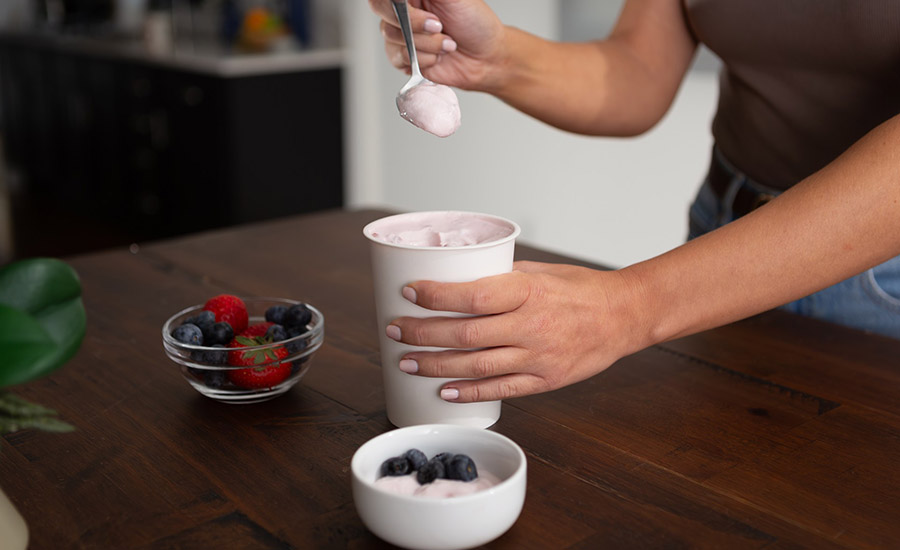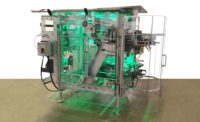How to select the proper primary packaging
Not only must processors leverage designs with the proper functionality, but the packaging must also meet their cost and sustainability requirements.

Size, texture, and durability are key processor packaging considerations. Photo credit: Fogg Filler Co.
Primary packaging is a key element in the drive by dairy manufacturers to maximize dairy revenues and enhance food safety. But identifying the optimal solutions including material type and container size and design for specific brands can be arduous.
Not only should dairy processors leverage designs with proper functionality, but the packaging must also meet specific cost and sustainability requirements. As more shoppers seek convenient and easy-to-use containers that are available in a variety of shapes, sizes, and materials, there is greater pressure on operators to incorporate the ideal options, analysts say.
“Success means having a solution that keeps food safe and protected, reduces waste, and achieves the desired visual presentation for consumer appeal, along with economical packaging that runs on existing capital equipment reliably and at operational speeds,” says Christopher Gabriel, director of strategic marketing, dairy, for TC Transcontinental Packaging, a Chicago-based flexible packaging provider.
Appearance is crucial, as primary packaging can have a major impact on brand image, suggests Beth Romano, product manager for Huhtamaki Inc., a De Soto, Kan.-based packaging supplier. “The package provides the first impression to a shopper and must be attractive and distinctive enough to catch the consumer’s attention,” she notes. “The choice of packaging material and graphics should convey the brand message.”
Product shelf life is a major consideration too when evaluating primary packaging, says Alberto Picon, regional sales manager for Fogg Filler Co., a manufacturer of bottle rinsing, filling, and capping equipment and a division of Covington, Ky.-based ProMach Inc. Such production elements as UV sanitation for bottles and caps, HEPA air filtration, and a semi-automatic clean-in-place trough system will help maintain shelf life during the packaging process, he notes.
Geometry for bottle carrying, pouring, and storing; the exterior bottle texture, ease of use for consumers; attractiveness; cost; transportation requirements; and ease of sanitation or sterilization are further elements for processors to analyze when making packaging decisions, Picon says.
Processors should also consider consumers’ changing preferences when selecting primary packaging, says Jorge Izquierdo, vice president of market development for Herndon, Va.-based PMMI: The Association for Packaging and Processing Technologies. This can include interest in eco-friendly designs, a range of product sizes, and single-serve packaging, he notes.
“There is a shift toward smaller portions and convenient packaging options as people lead busier lives and resume more out-of-home activities following the pandemic,” Izquierdo explains. “Solutions like single-serve formats featuring resealable peel-off lids can meet consumers’ demands for convenience, size, and sustainability.”
“The primary factor behind the expansion of dairy product sales is the different types of packaging available,” states Mordor Intelligence, a Hyderabad, India-based research firm. This includes milk in portable brand-friendly polyethylene terephthalate (PET) bottles, “which is an attractive option for increasingly busy consumers,” along with yogurt in PET bottles instead of thin wall plastic containers as shopper interest “is compelling the manufacturers to focus on new packaging for the product,” the firm notes.

Rapidly changing consumer preferences toward packaged food and evolving economic scenarios also are significantly impacting the U.S. dairy packaging sector, Mordor Intelligence reports, adding that “considerable expansion of the dairy product portfolio, primarily into sports nutrition, along with an increasing number of casual users, is expected to drive the market further.”
A plethora of considerations
Processors should analyze their production priorities and goals when making packaging decisions, including current and future output; how a design might impact upstream and downstream operations; and the difficulty in implementing and maintaining solutions, says Ryan Spencer, product marketing manager for Multivac Inc., a Kansas City, Mo.-based packaging equipment supplier.
In addition, processing employees must be open to novel concepts and be willing to receive training to learn about advanced packaging systems, he notes. “A shiny new packaging line can only be effective if the staff understands how the line operates and how they can keep it in good working condition,” Spencer says. “We have seen a beautiful and efficient packaging solution foiled not because of technical challenges, but because there were people who resisted the changes the solution necessitated.”
A shift toward sustainable packaging, meanwhile, is taking center stage as more dairy processors seek to reduce the environmental footprint and contribute to circularity, says Mark Roberts, Huhtamaki senior product manager. That includes incorporating designs with minimal materials that are recyclable or compostable, he states.
While consumers still list hygiene, food safety, and shelf life as the most important aspects of product packaging, “sustainability continues to be an increasingly important issue for the packaging value chain,” states McKinsey & Co., a New York-based strategy and management consulting firm. “As societies emerge from the COVID-19 pandemic, consumer sentiment is evolving away from a hyperfocus on hygiene and sustainability pressure is building once again.”
Manufacturers and retailers of fast-moving consumer goods (FMCGs) continue to innovate packaging formats to improve circularity, with a focus on such recycled content as post-consumer resin, McKinsey states. “These innovations come as players seek to deliver on their own sustainability commitments and address consumer expectations, nongovernmental organization voices, and new packaging regulations.”
Regulations governing sustainability, such as proportions of recycled content, is expanding on multiple fronts and is no longer confined to select countries or regions, McKinsey notes, adding that many consumers state they are willing to pay more for sustainable packaging.
“The industry is working to achieve a circular sustainable economy by developing products that reduce waste and increase recycling rates,” TC Transcontinental’s Gabriel says. “These innovations largely focus on recyclable mono-material structures, advanced compostable films, and increasing the use of post-consumer recycled content.”

While he notes that such “technically challenging platforms” can deliver sustainable solutions that meet or exceed the durability and high performance of traditional flexible packaging products, Gabriel indicates that such solutions may require higher equipment expenses and adherence to extended producer responsibility (EPR) laws. The EPR laws might require producers to provide funding and/or services that assist in managing products after the use phase.
“This regulatory framework around ERP laws and approved recycle-ready structures involves complicated producer responsibility cost calculations, which are still being determined, and vary from state to state,” he notes. “Bringing a sub-optimal packaging solution to market can be very costly to processors.”
Pick the right partner and plan
Processors can better manage such complexity by collaborating with vendors that can guide them through a transition to sustainable packaging, Gabriel states. This includes suppliers with the technical expertise to develop the right product; have state-of-the-art equipment that delivers solutions at scale; and possess a complete understanding of the ever-changing regulatory environment, he notes.
“Legislation is driving packaging choice and, therefore, may present challenges to processors when choosing the most effective package,” Romano says. “Sustainable solutions will need to fit regional, state, and national levels with foam bans and single-use plastic bans being debated at state and regional levels. New materials and equipment may be needed when considering the best package.”
Producers incorporating sustainable materials also should monitor potential drops in productivity due to the new elements, Izquierdo states. It’s also important for operators to work closely with their material and equipment suppliers to plan equipment adjustments or retrofits.
“Partnering with the right supplier can provide reliable service, innovation, transparent communication, efficient distribution, and a breadth of options and raw materials,” Romano says. “This assures mutual requirements are met and there is alignment to provide the most cost effective and sustainable solutions while ensuring the packaging protects consumers, preserves food, and helps promote the brand.”
Working with reputable equipment suppliers who understand specific products and applications also will enable processors to identify operational challenges, adds Rudy Sanchez, food handling systems product manager at Key Technology Inc., a Walla Walla, Wash.-based food processing machine manufacturer.

Packaging, meanwhile, keeps evolving with more designs supporting portion control and snacking, Spencer says, adding that distinctive forms with visually interesting art; clever copy on the film or label; and easy-opening and reclosable features will further enhance dairy selections.
“Many brands are turning to unique design features that make their products stand out, which may include package shapes or visibility to see inside the package,” notes Kate Farley, director of sales for Modern Packaging Inc., a designer and builder of automatic filling and sealing machines and a division of ProMach Inc.
Protect the package
More packaging options also feature high-density polyethylene (HDPE), which lightens bottles and enables better material distribution, and PET, which supplies more consistent neck finish properties that enable greater packaging line efficiencies, Picon states.
“Lightening bottles and caps have been the latest packaging industry focus, but the approach has a limit as the lighter the bottles, the easier they can be dented or damaged before filling, and damaged bottles will reduce the efficiency of all equipment in a bottling line,” he says, adding that because HDPE and PET are oil price dependent; cost is always a key concern.
While processors can minimize transportation damage and contamination risk by blowing bottles onsite, space challenges exist as most dairy facilities are crowded with equipment and many are in locations that prevent operators from expanding adjacently, Picon notes.
In addition to meeting visual size and shape requirements, the optimal primary packaging will have the durability to withstand the secondary packaging process, which includes case packing and palletizing, says Tom Wiersma, business development manager for Integrated Packaging Machinery, a Rockford, Mich-based packaging system developer.
For instance, incorporating thinner materials when transitioning from plastic yogurt pots to plant-based recyclable board cartons makes the packaging more susceptible to downstream damage, he concludes, which can include leaks, tears, carton wear, and the marring of brand colors and images.
Looking for a reprint of this article?
From high-res PDFs to custom plaques, order your copy today!






